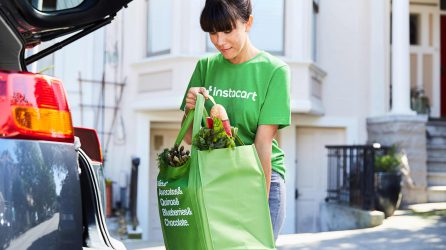What the smartest CPGs get right about selling on Instacart

Presented by:
Stephanie Rubin — 2022
This post has been updated and was originally published March 30, 2021.
It's time CPGs get ready to win on Instacart. So read and learn:
- What's all the hype around Instacart and why CPGs should care
- Why CPGs need to act on the first-mover advantage now
- What CPGs need to get right to drive online sales
Winning the digital shelf with Instacart
What a difference the past years have made.
One of the most striking changes I have seen in eGrocery over the past 24 months is the change in attitudes toward Instacart.
Sure, Instacart was on the radar even before the Covid-19 pandemic, and CPGs were certainly interested in learning how to do well on the platform. But with Instacart typically accounting for just 1-5% of sales, there was no great sense of urgency around formulating winning strategies.
Then Covid happened and sales via Instacart exploded. For many of the CPGs we work with, they at least tripled. Last year, Instacart accounted for more than half of the US online grocery market. As a result, figuring how out to get a competitive advantage and win on Instacart has jumped to the top of the agenda.
Instacart sales aren’t the only thing that’s exploded; general media interest in the company has also soared. Whether it’s the high-profile partnership with Walmart or its much-anticipated IPO, Instacart is being analyzed and scrutinized more than at any point in its nearly ten years history.
Over the recent past, the company has made headlines amid speculation it wants to switch to robotic warehouses to fulfill its orders – a move some have interpreted as a sign it ultimately wants to launch a grocery business of its own.
In all this, the smartest CPGs have resisted the noise about Instacart’s business model and focused on the two things that actually move the needle when selling on the platform: getting into shoppers’ baskets early and getting your search strategy right.
Let’s explore these in a little more detail.

Why CPGs must get into Instacart baskets early
Shoppers are creatures of habit. We buy the same stuff over and over again, and once we’ve developed a preference for a particular product or brand, it takes a lot for us to try something new.
This is especially true when shopping online. The very experience of walking into a bricks-and-mortar store encourages impulse purchases and prompts us to buy new things. No matter what we’ve put on our shopping list, we can’t help but notice a whole range of products as we wander the aisles. That isn’t the case with eCommerce, where the path to purchase is much more streamlined and tailored toward shoppers’ habits and preferences.
Instacart in particular excels at making it easy and convenient for shoppers to stick with familiar choices. Like most eGrocery platforms, it has a ‘buy it again’ widget that allows shoppers to repeat previous purchases. Unlike other platforms, however, Instacart has made this widget the first thing you see when you log in. Before you get to anything else, you are prompted to load up your basket with items you’ve bought before.
The implications for CPGs cannot be overstated. On their first Instacart shopping trip, shoppers add about half the items in their basket through search and the other half through looking at the pre-populated category browse aisles.
After that first shopping trip, the importance of category browse aisles progressively diminishes and the ‘buy it again’ widget becomes more dominant. By the time a shopper has completed 10 to 15 trips on Instacart, browsing has been relegated to third place behind search and ‘buy it again’.
That’s why CPG brands need a strategy for getting into the baskets of new Instacart shoppers as soon as possible. When consumers adopt a new habit, like buying groceries on a new eGrocery platform, they are learning a new behavior and are therefore more open to exploring new products and brands. Once they’ve made three to five trips, this willingness to experiment plummets and shoppers are building their shop increasingly from past purchases. If you’re not in the basket by this stage, you’re in trouble.
Kiri Masters, co-author of the book Instacart for CMOs, sums it up brilliantly: “Instacart’s unique ability to prompt repurchases should light a fire under the tail of brands: you must get into the customers’ basket now, as you will reap the rewards for years to come in the form of repeated purchases.”

Why getting search right will be key for your Instacart marketing strategy
Winning on Instacart isn’t just about getting into baskets. Search is absolutely critical, and an area no brand can afford to neglect. When CPGs get it wrong on Instacart, it’s often because they are not focusing enough on their search results.
Instacart shoppers disproportionately shop on the app as opposed to on desktop. This raises the bar for search performance. Historically, on desktop, the top row of search results might display five items, with anywhere from 10 to 20 items shown above the fold. On mobile, the number of items you get above the fold is four.
With Instacart previously disclosing that a massive 70% of conversion from search on its platform happens in the first row, the message is clear: to win on Instacart, CPGs must develop a solid search strategy.
Once again, the need to get into baskets early also comes into play here. Instacart is focused on personalizing every part of the shopping experience, including search. Using AI capability, it tailors the search experience to the shopper and the shopper’s preferences, so over time search results reflect past purchases.
It all adds up to a much more curated experience than on other eGrocery platforms, meaning CPGs have little margin for error. If your search strategy isn’t right from the start and you’re not getting into those baskets nice and early, you’ll struggle to embed yourself into consumers’ new online shopping routines.
For those who get it right, however, the rewards are potentially huge. Instacart is undoubtedly one of the big winners of the eGrocery and delivery boom of the past couple of years, with vast swathes of online grocery spend now funnelled through its platform.
With the right strategies – focused on getting into baskets early and optimizing search performance – CPGs have every opportunity to leverage Instacart’s success into a resounding eGrocery win for themselves.
All the digital Shelf Analytics You Need to Succeed at Speed & Scale
See why world leading brands choose e.fundamentals for actionable digital shelf insights
Request A demoLatest Resources

CommerceIQ Launches Global Retail Ecommerce Management Platform Combining Sales, Supply Chain, Retail Media, and Digital Shelf with e.fundamentals Acquisition
Ecommerce platform enables consumer brands to grow market share profitably in today’s inflationary and supply-constrained environment through intelligent automation, supporting over 450 omnichannel retailers in 41 countries.

e.fundamentals becomes a CommerceIQ company
e.fundamentals has been acquired by CommerceIQ, the leading Retail Ecommerce Management Platform, headquartered in Palo Alto, California. Consumer brands can now harness one global software platform to power profitable market share growth across all major retailers.

5 strategic pricing opportunities CPGs should focus on now
As tensions run high between retailers and suppliers, CPGs need to be smarter than ever about strategic pricing. Here’s how to use digital shelf analytics to hold your own in tough negotiations.

What the smartest CPGs get right about selling on Instacart
This post has been updated and was originally published March 30, 2021. It's time CPGs get ready to win on Instacart. So read and learn: What's all the hype around…

5 optimization tactics to grow digital shelf sales
This post has been updated and was originally published May 14, 2020. Consumer goods companies (CPG) continue to grapple with enormous shifts to the industry as the eCommerce boom continues…

5 tactics to grow online sales for category managers
Category management has changed. We've highlighted the 5 tactics to help you scale your growth on the digital shelf at speed.
View Our Most Popular resources to help you learn and win on the digital shelf.

The Ultimate Guide to Content Management on the Digital Shelf

The Digital Shelf Cast - Listen to our latest episode





